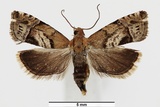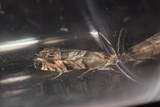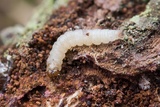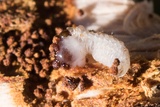Cydia interscindana (Möschler, 1866) Species
Last modified: Nov. 25, 2025, 12:11 p.m.
A very rare and local species in Belgium, not often recorded.
Details
- Classification
- Family: Tortricidae > Subfamily: Olethreutinae > Tribus: Grapholitini > Genus: Cydia > Species: Cydia interscindana
- Vernacular names
- Zonnegloedbladroller (NL), Juniper Piercer (EN), Zedern-Wacholder-Wickler (DE)
- First mention in Belgium
- Coenen F. 1981b. Cinquième contribution à la connaissance des microlépidoptères de Belgique. Cydia interscindana Möschler (Lep. Tortricidae) espèce nouvelle pour la faune belge. — Linneana belgica 8: 359–362. On page 359.
- Status
-
Native
Distribution
Imago
Wingspan 10–12 mm. The adults can be attracted by the pheromone originally developed for Cydia pomonella.
Mine
The larva mines the branches and trunk of the host plant. The mines are full of frass and reaches the phloem. The plant tissue around the mine becomes loose, slightly swollen, somewhat sponge-like, this tissue is consumed by the larva.
Bionomics
Mines can be found on branches and trunks. Hibernates as mature larvae and pupate in early spring. Adults come to light.
Flight periods
The adults are on the wing from mid-June towards mid-September in two generations a year.
Observed on
- Host plant (species):
- Juniperus communis
- Host plant (genera):
- Juniperus
The larva lives on Juniperus and on various cultivated conifers (Cupressaceae) such as Cupressocyparis leylandii, Chamaecyparis lawsoniana and Platycladus orientalis.
Habitat
It inhabits gardens and parks planted with cultivated conifers and on calcareous ground with Juniperus.











